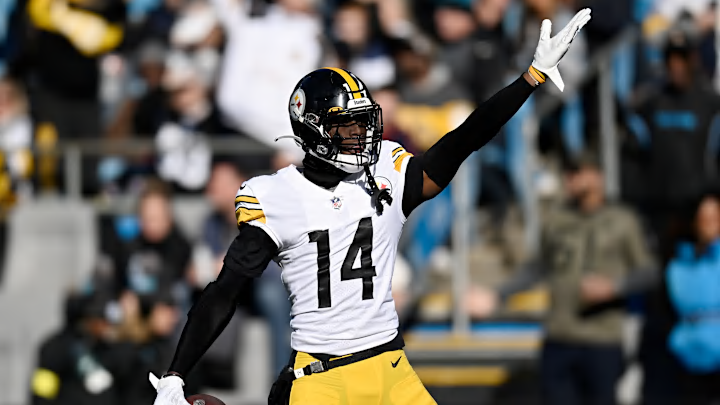Route-Running & Separation Creation
Coming out of Georgia, George Pickens was not known as a particularly refined route runner that could break off any defender on any route. Instead, he was a physical specimen that routinely got open on deep routes, and even when he didn’t, he displayed an incredible catch radius and solid hands that could make spectacular grabs. Pickens was a young entrant to the 2022 NFL Draft, plus he was coming off a year where he missed essentially the entire season. He only appeared in 25 games over three seasons, with just over 1000 career offensive snaps.
Given this relative inexperience and lack of refinement, it makes sense that Pickens was asked to execute a relatively basic route tree and was more successful on simpler routes. Per TruMedia, he was primarily tasked with running Go and Hitch routes, compromising about 38% and 20% of his routes, respectively. No other route comprised greater than 8% of his routes ran. One could argue these are two of the simplest routes any receiver can run.
Another interesting number from NFL Next Gen Stats: among receivers with at least 45 targets, George Pickens finished with the 11th-fewest average yards of separation per target at 2.4 yards. Again, there is some noise involved in this number; it only looks at targets as opposed to all routes, so a significant portion of the data is left out. It’s more about the receiver’s ability to make tough catches rather than get open, which we already knew was one of Pickens’ strong suits.
Naturally, the next question would be, “How consistently did Pickens get open when running each of these routes?” This question cannot be answered as easily by statistics. One could look at the percentages of how often the receiver was targeted on those routes or how frequently the receiver caught those targets. However, there is a lot of noise in these numbers, making them essentially irrelevant.
There is one source that created some interesting numbers on this topic. Matt Harmon of Yahoo Sports has developed a framework to evaluate a receiver’s success rate across an entire route tree. He recently published his profile of George Pickens (which is behind a paywall) and also tweeted out these charts displaying Pickens’ route frequencies and the success rate across those routes.
Here's exactly how often Pickens ran a slant or curl (and how often he got open on them) in the games I WATCHED and charted to get these analytical numbers.
— Matt Harmon (@MattHarmon_BYB) May 15, 2023
For context. https://t.co/QkRduEOdM7 pic.twitter.com/VLwuEbczIg
Harmon expressed concerns about Pickens’ ability to consistently separate against Zone coverage, especially on shorter, more complex routes. He cited a 68.3% success rate against Zone, which sounds good in a vacuum, but was in the 5th percentile for receivers in his database. Generally, I would agree with Harmon’s contention.
When Pickens has deeper, longer-developing routes, he has time to read the defender’s positioning and leverage, giving him more information on how to attack said defender. On shorter, quicker routes, however, he does not have the experience or the mental processing ability to know how to manipulate and attack those defenders.
It's time to talk about some of the concerning marks in George Pickens' #ReceptionPerception profile pic.twitter.com/ntlaqFx98j
— Matt Harmon (@MattHarmon_BYB) May 15, 2023
As to what actionable measures Pickens can take to improve his game, specifically regarding his route running and ability to create separation, it comes down to wasted motion. When reviewing Pickens’ film, it was apparent that he moves very loosely. This isn’t always necessarily bad, as it is a very natural and fluid style. However, it uses up a lot of time and unnecessarily expends energy.
When I think about great route runners in the NFL, prime Antonio Brown and Keenan Allen come to mind. These players are exceptionally intentional in their routes and do not waste a bit of motion. They are crisp and sudden when running routes and attacking defenders. When a receiver runs routes more like Pickens, it gives the defender time and clues as to what route is coming. It can also throw off the timing of the route, leading to incompletions.
On one hand, I don’t want Pickens to completely change his game such that his best traits are neutered. But on the other, if he adjusts how he runs his routes, it could pay massive dividences to his contributions to the Pittsburgh Steelers. Similar to pitchers in baseball, you don’t want to completely change up their motion and delivery, as it could create unintended negative consequences. But as I will discuss further in this piece, if Pickens tightens up his route running, it could have positive trickle-down effects on the rest of his game.
